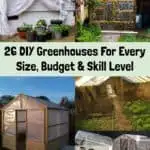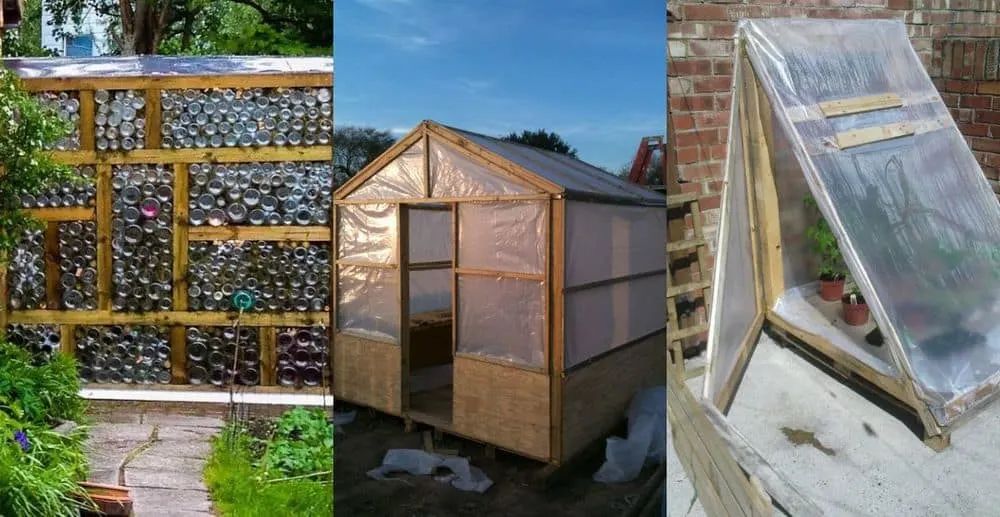
You will find plenty of compilations on the web describing many of the best DIY greenhouses that people have made.
In this article, however, we will not only gather some of the best ideas and resources from around the web, but also discuss why you might wish to consider each of the options we suggest.
We will cover options for gardens big and small, for those with tiny budgets and those with rather more money to spend.
You will find options that use a wide range of different materials, which are suitable for experienced builders, and for those with little to no DIY experience.
But all our ideas share one thing in common – they work well, and will help you to successfully grow your plants.
Before we take a look at some of your options, let’s examine the idea of a greenhouse a little further.
Thinking about why you want a greenhouse, which types of greenhouse you should choose, whether you should build your own greenhouse, and how to choose a location for your DIY greenhouse can help you narrow down your choices and get the best possible results.
Pin This To Save For Later
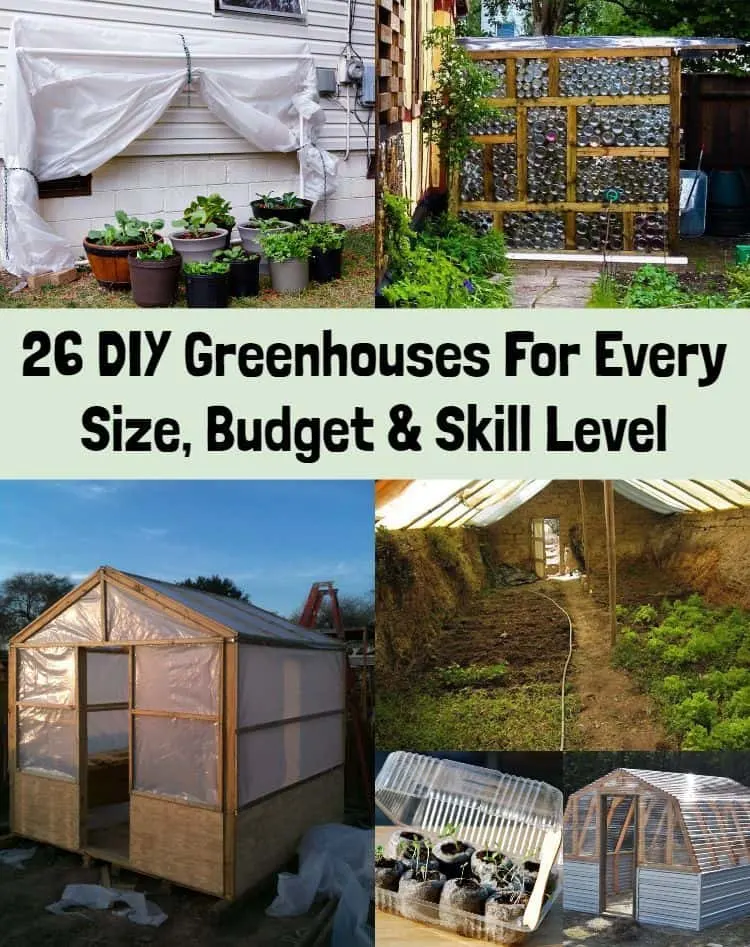
Why is a Greenhouse a Good Idea?
Building a greenhouse, hoop house, polytunnel, row cover or cloche can be a great idea for home growers. They can, of course, be especially helpful for those who grow their own food. A greenhouse can:
- Extend the growing season, making it possible to grow earlier in spring and later in the fall and even, sometimes, all year long.
- Extend the range of crops that it is possible to grow where you live. (Often, a greenhouse will allow you to grow crops usually better suited to warmer climes.)
- Protect your plants from extreme weather conditions – snow, storms, heavy rain, strong winds etc..
- Provide a level of protection from pests that might eat your plants before you get the chance to do so.
- Larger greenhouses or hoop houses/ polytunnels can also make gardening more pleasant for the gardener in inclement weather conditions and chilly temperatures.
Should You Go For Glass or Plastic?
One of the decisions that you will have to make when considering which of the DIY greenhouses could be right for you is whether you would like to clad your structure in glass or plastic.
Greenhouses were traditional glass-windowed structures. But since the invention of plastics, these have become ubiquitous in all arenas of life. The gardening world is no exception.
Many greenhouses and other similar protective structures are now clad in plastic rather than glass.
While buying glass greenhouses is still common, plastic is a more popular choice for DIY greenhouses.
Plastic is more flexible than glass, cheaper, and less prone to breakage. Thinner polyethylene sheeting and more rigid plastic sheets are both now common in greenhouse or hoop house/polytunnel construction.
These generally have slightly poorer heat retention than glass greenhouses – but can still do an excellent job of protecting your plants.
Some people might prefer to use glass as they are concerned about the problem of plastic pollution, and so want to reduce plastic use in their gardens. It is worthwhile considering, however, that by reusing/recycling plastic to make a greenhouse, you could help to keep plastic out of the waste stream. Using reclaimed plastic and other reclaimed materials to make DIY greenhouses is just one of the ways you could reduce waste.
It is also worth noting that the plastic used to make greenhouses, even if bought new, is usually relatively long-lasting, and is often a type that can be recycled at the end of its useful life.
Why DIY?
Whatever you choose to use to build your greenhouse, there are a number of reasons why it is a good idea to do it yourself rather than buying one:
- By using natural or reclaimed materials, you can reduce your impact on the planet. A DIY greenhouse will often have a far lower carbon cost and environmental impact than a bought greenhouse.
- Building your own greenhouse can save you a lot of money. The cost of building a greenhouse can vary considerably. However, you can get a useful, usable structure to protect plants for next to nothing – even the most elaborate plans described below can still be far cheaper than buying one ready-made,or having someone else build one for you.
- DIY greenhouses can be fun and rewarding to build. You can learn some new skills or enhance old ones. It can also be enjoyable to dig in and build something with your own hands. Plus you will have the satisfaction at the end of the process of a job well done, and boasting rights, of course!
However, a complex DIY project might not be for everyone. When choosing a DIY greenhouse project to tackle, it is important to be realistic about your handiness level, how much time you have, and whether you can manage it within your budget.
Don’t worry, however,even if you rule out a more complicated structure, there are still simple DIY greenhouse options that anyone can try.
How To Choose a Location For Your DIY Greenhouse
You might locate a greenhouse or other, similar protective structure:
- on a balcony, patio or other small outside space.
- against your existing home.
- As a free-standing structure in your garden.
- On an allotment or community growing space.
Thinking about where you will place your greenhouse is as important as choosing the right materials and the right design.
When deciding where to place your structure it is important to consider:
- The levels of sunlight in a certain spot, and the temperatures it will likely experience.
- Whether the location is windy and exposed, or sheltered.
- Whether wildfire is an issue where you live, and if so, which direction these might approach from.
- Whether the soil is good in that location, and if raised beds will be required.
It is best to build your greenhouse in a sunny spot, out of extreme winds. But even on challenging sites and in challenging locations, there will often still be a DIY greenhouse that could fit the bill.
27 DIY Greenhouse Ideas
Now that you have taken a little time to consider the above, it is time to take a look at some of the wonderful DIY greenhouse ideas that you could try:
Passive Solar Greenhouse
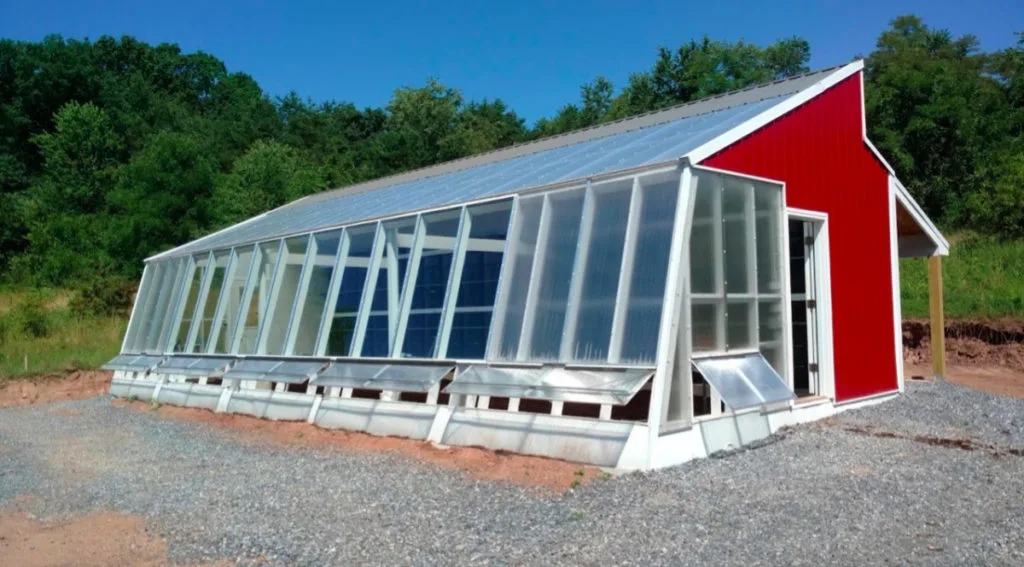
If you live in a temperate climate, but want to grow exotic edibles all year round, then this passive solar greenhouse is the perfect design for you.
Matthew, a Rural Sprout contributor, and his wife Shana built this eco-friendly greenhouse that keeps cool in the summer and warm through the winter. Matthew is able to grow citrus trees in his greenhouse despite the unpredictable Pennsylvania weather.
Micro Container Greenhouse
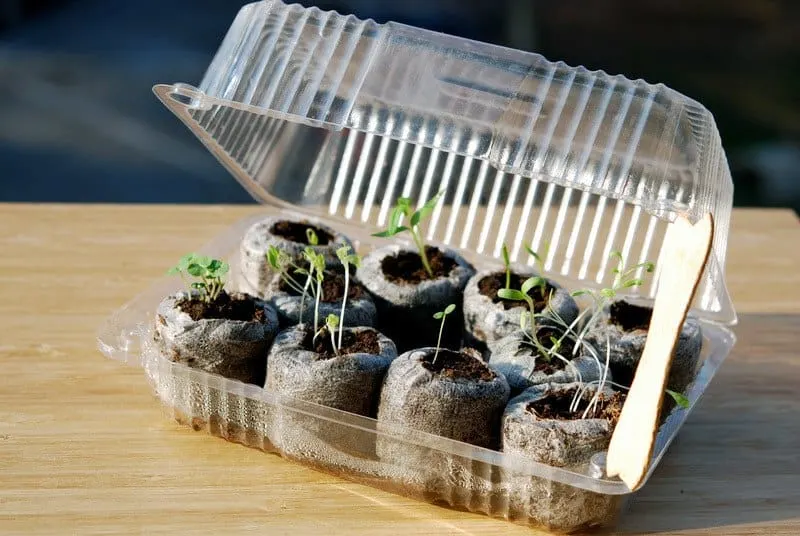
You can use all sorts of plastic food packaging to make micro greenhouses.
This micro container greenhouse, for example, demonstrates how you could protect a single plant, or some seedlings using recycled items and keep those items out of landfill.
These mini greenhouses, or cloches as they are sometimes known, are one way to create a level of protection and a micro-climate for plants without spending any money at all.
Get the full tutorial at NewEngland.com
Mini CD Case Greenhouse
It is not only food packaging that can be reused for this purpose. You can also make mini greenhouses using plastic items from around your home that would otherwise have been thrown away.
For example, you could use old plastic storage boxes, bubble-wrap from packaging or the protective film that comes over the screens of new televisions and other electronic devices to make small DIY greenhouses.
But one of the coolest and most attractive suggestions, in the link below, is to use the plastic cases from all your old CDs.
Get the full tutorial at TaunieEverett.com
Bubble Umbrella Greenhouse
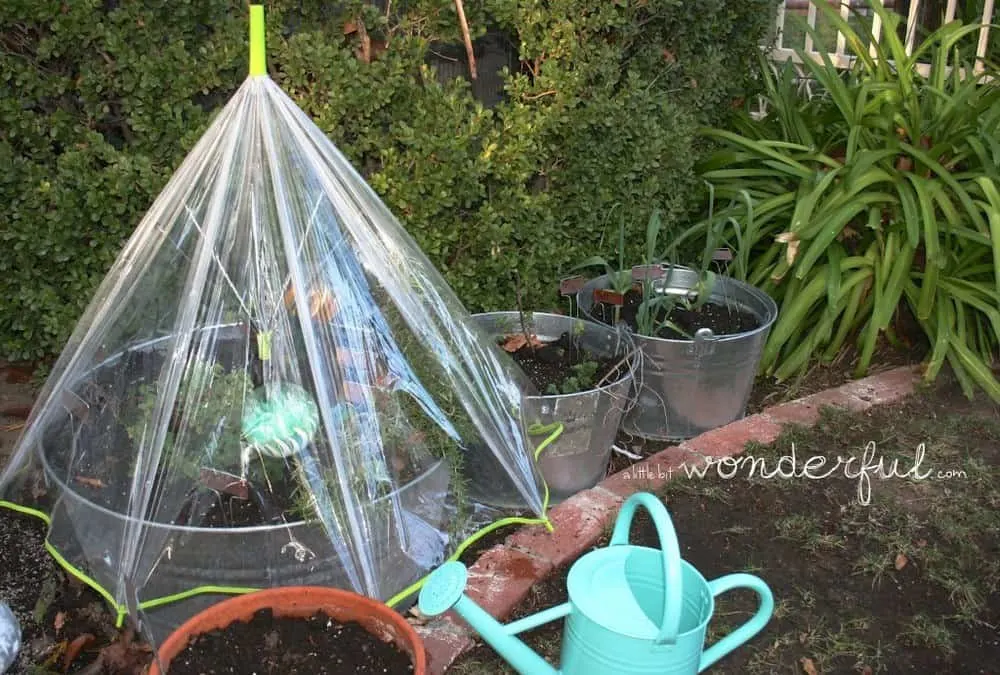
All sorts of everyday items can be reused in your garden rather than thrown away. One item that is often difficult to recycle at the end of its useful life is the umbrella.
In the example given below, a clear bubble umbrella has been placed to form a mini greenhouse for a container. But you could also use the frame of an old umbrella to make the structure of a new mini greenhouse and replace the fabric with some clear recycled or reclaimed plastic.
Get the full tutorial at ALittleBitWonderful.com
Recycled Window Hothouse For Small Spaces
Using reclaimed windows is not only for large gardens. This small hothouse design could work just as well for a small patio, or a balcony garden as it would in a larger space.
Get the full tutorial at BalconyGardenWeb.com
Small-Space Wood Pallet Greenhouse
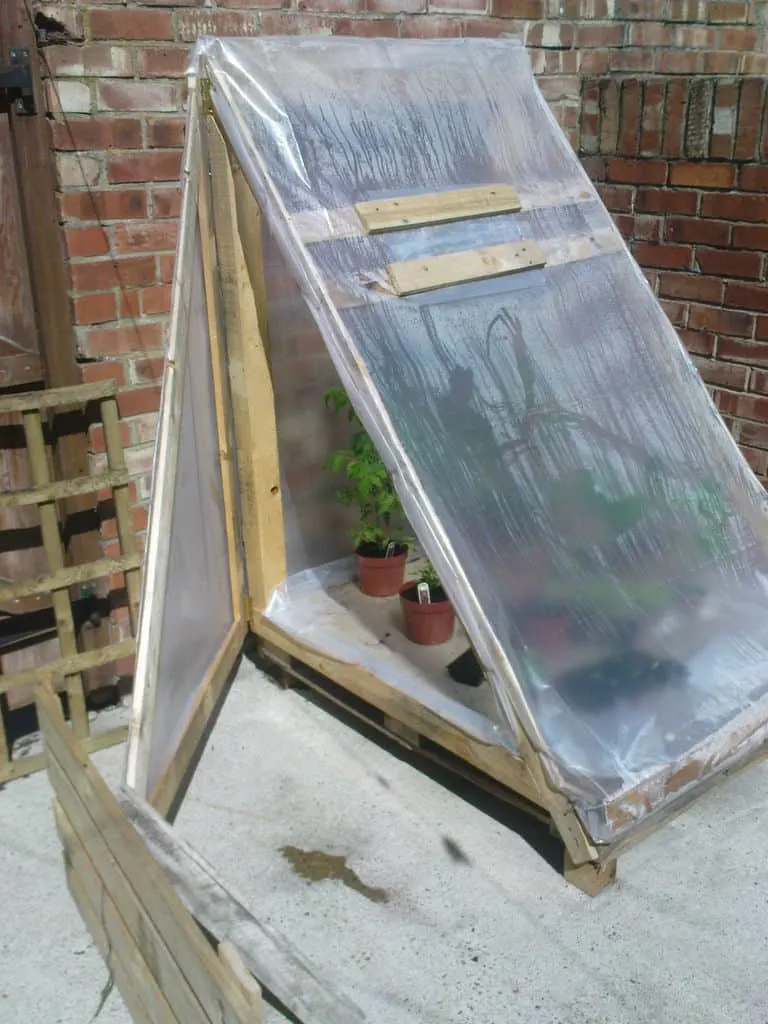
There are a whole raft of different wooden frames that you can create to support the plastic sheeting on a small-space DIY greenhouse.
This plan stands out for its simplicity, its suitability to small spaces, and for the fact that it is made from wood from an old wood pallet. This is one of many garden DIY projects for which old wood pallets could come in handy.
Get the full tutorial at Instructables.com
DIY Folding Greenhouse
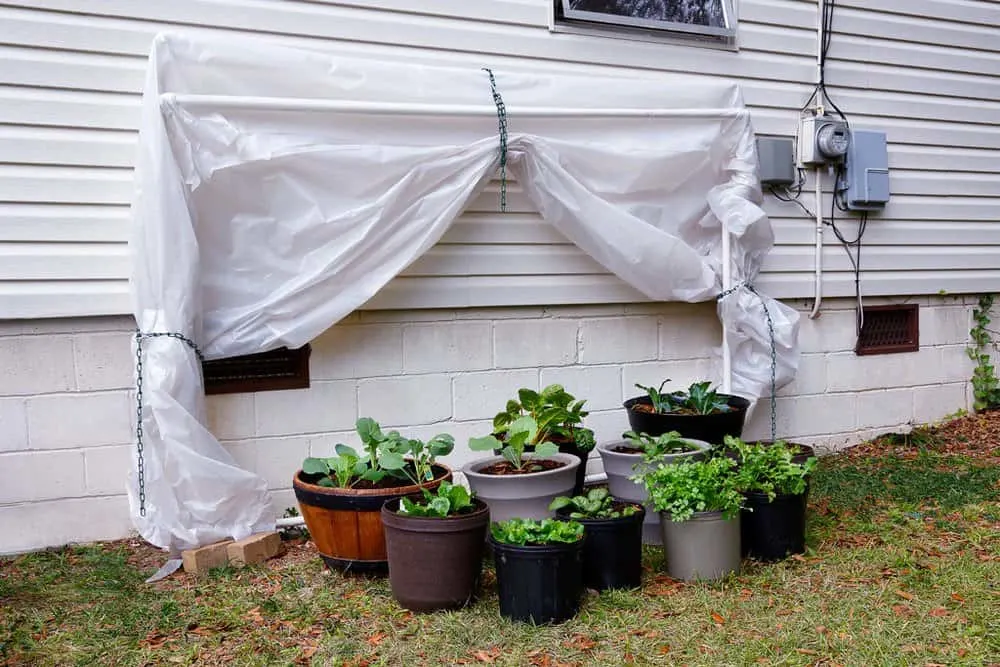
But what if you have a small space that needs to be used for more than just a greenhouse?
A DIY folding greenhouse, that you can fold away neatly when it is not in use, could be just the solution that you are looking for. The space it occupied could then be used as a seating or recreation area – or something else. In small spaces, every inch should be utilised, and ideally for more than one thing.
Get the full tutorial at BonniePlants.com
Upcycled Trampoline Greenhouse
It is not only micro and mini greenhouses that you can make using reclaimed or repurposed materials from elsewhere in your home.
The clever idea in the link below uses as old trampoline’s metal circular frame to create two arches for a smallish tunnel-shaped greenhouse. The same principle could be used to create a smaller row-cover from a mini trampoline.
You could also use the metal frame from an old tent, for example,or fibreglass tent poles, in a similar way.
Get the full tutorial at HowDoesShe.com
PVC Pipe Tomato Tent
One of the most common ways to make a small polytunnel to cover a growing area or garden bed is to create a structure using PVC pipe.
The link below shows how to make such a structure that is tall enough to accommodate, for example, a row of tomato plants. As you will discover below, PCV pipe is used in several different larger DIY greenhouses as well. Using reclaimed piping would, of course, make this a far greener and more sustainable choice.
Get the full tutorial at SowAndDipity.com
Remember that you may have to hand pollinate tomatoes grown in an enclosed greenhouse.
PVC Pipe Hoop House
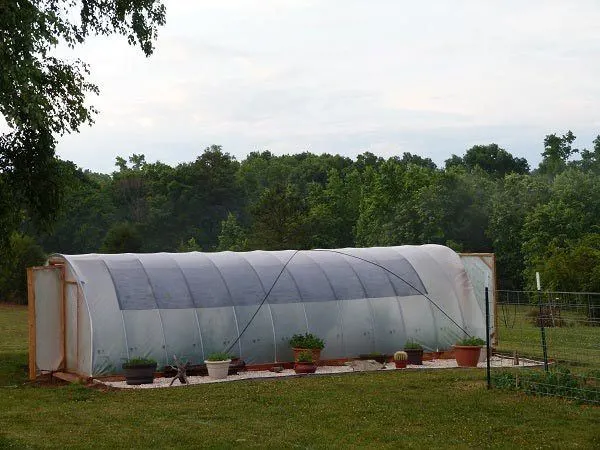
As mentioned above, there are a wide range of DIY greenhouse plans that utilise PCV pipe to make the support structure for the plastic. The link below gives detailed instructions of one way to create a large hoop house structure.
Get the full tutorial at NaturalLivingIdeas.com
Large PVC Pipe Hoop House
These alternative plans show how you can create a hoop house with PVC pipe and a wooden base rail, and also make clear how you can use this basic technique to scale up the project and make much larger polytunnel/ hoop house structures.
One of the great things about all these hoop house style plans is that they can create sizeable growing areas – far larger than those that could be easily achieved with glass and wood.
Get the full tutorial at BaileyLineRoad.com
A Bamboo (or Hazel wood, or other bendy branch) Polytunnel
So many of the tunnel-type DIY greenhouses described on the Internet involve the use of PVC piping to create the structure – so it can be refreshing when you come across something else.
This cool idea demonstrates the use of another versatile – but natural – building material: bamboo.
Bamboo is strong and super sustainable – it could be a very good choice for those who want to make their new greenhouse as green as possible. If you don’t have access to bamboo, how about using hazel wood or other bendy branches to make the structure? Using natural materials like these could keep costs down, as you may be able to source these things for free.
Get the full tutorial at Permaculture.co.uk
Recycled Car Port Greenhouse
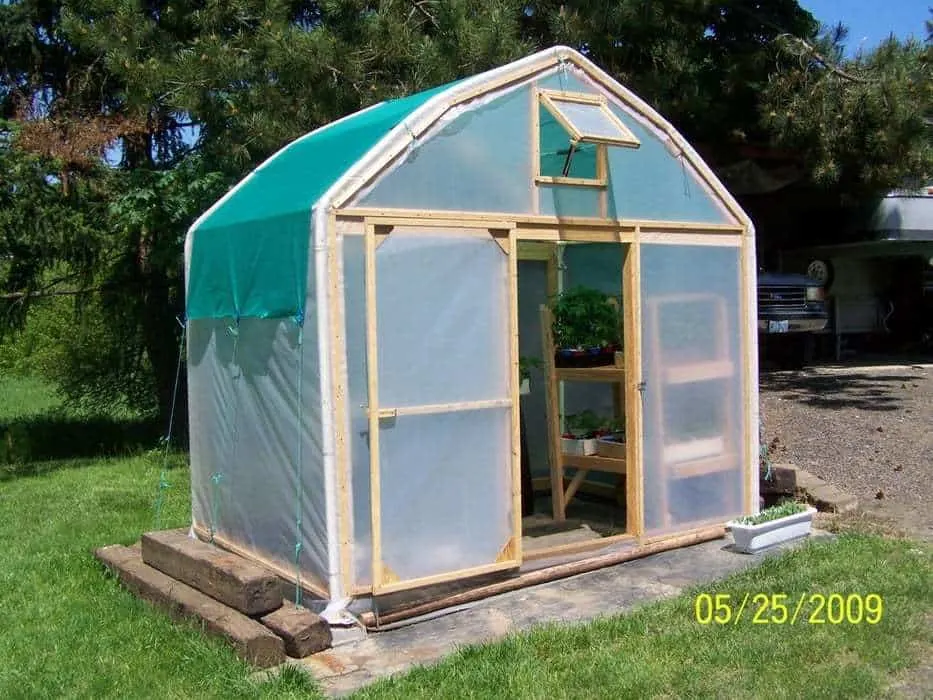
Using natural materials is one good way to be green. But so is reusing things that might otherwise have been discarded.
This DIY greenhouse uses the frame from an old carport to make a relatively large greenhouse structure.
Get the full tutorial at Instructables.com
Barn Shaped Greenhouse
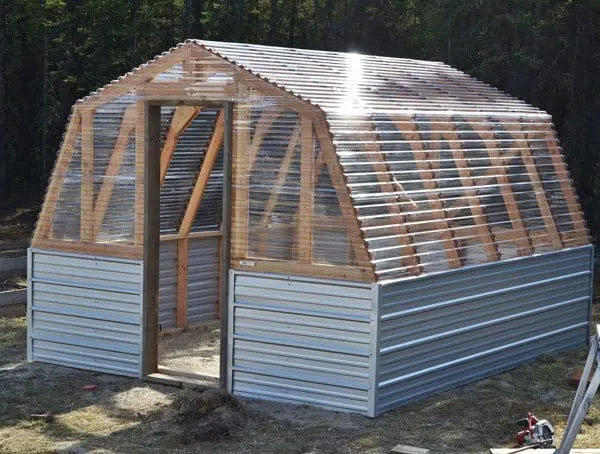
These attractive barn shaped DIY greenhouse plans explain step by step how to make this greenhouse, which could fit in perfectly on a rural property – or bring a feeling of the countryside to a town or city garden.
Get the full tutorial at Ana-White.com
Roof Ventilation Greenhouse
One of the downsides to growing inside a tunnel or a more traditional greenhouse is that the space inside can be difficult to ventilate.
This DIY greenhouse incorporates a split-level roof, allowing for ventilation flaps or windows to be added at the top. With its excellent ventilation, it could be a good choice for warmer climate gardens.
Get the full tutorial at BuildEazy.com
Affordable, Strong, Wood-Frame Greenhouse
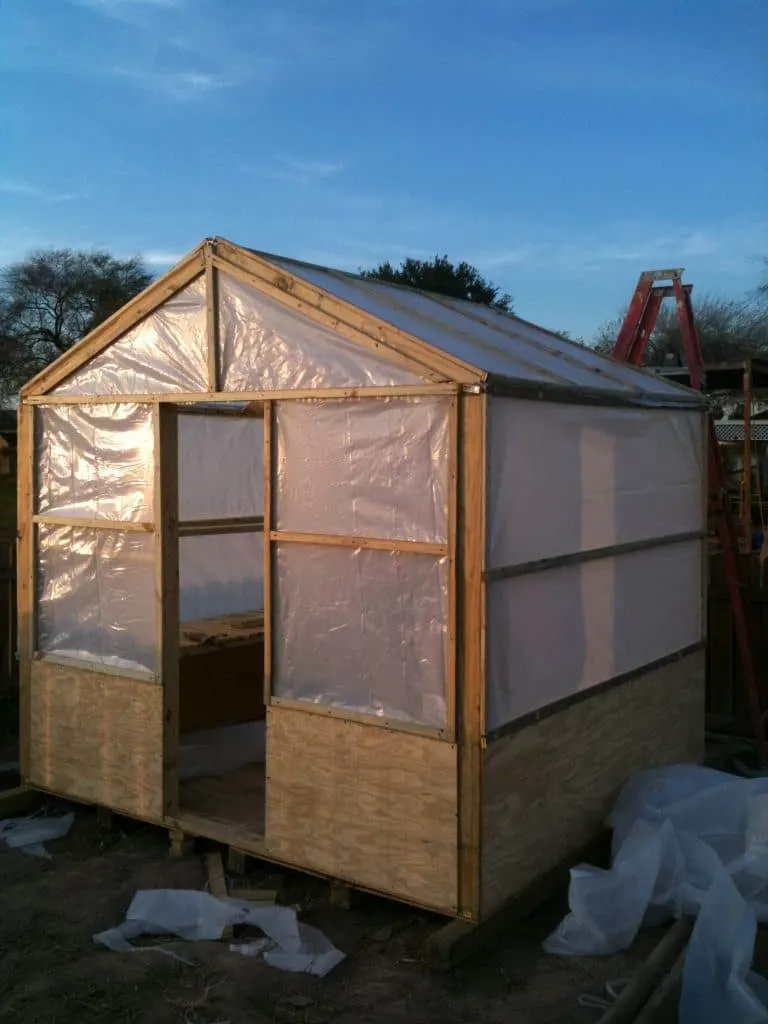
Building a sturdy, strong, wood framed plastic greenhouse does not need to cost the earth. This is just one of the excellent examples that show just what it is possible to achieve on a relatively small budget.
Get the full tutorial at Idea On A Farm
DIY Geodome Greenhouse
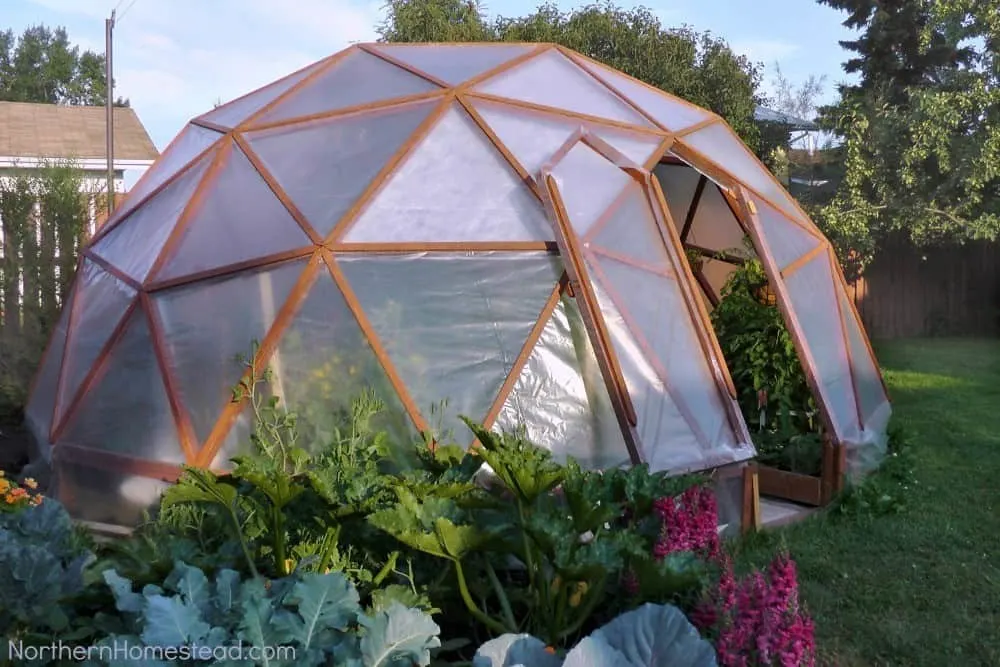
If you want to try something a little different then why not think outside the box and build a geodome greenhouse.
This DIY project does involve more complex joinery, and might not be a good choice for beginners. But if you already have a number of DIY projects under your belt and are looking for a new challenge it could be an interesting option for you.
Get the full tutorial at NorthernHomestead.com
Geodesic Dome Solar Greenhouse
This amazing idea takes the geodesic dome and turns it into something truly special – a solar greenhouse ideally suited to your food growing needs.
Again, this is not the most simple of DIY greenhouses, but could be an amazing way to up your game in your sustainable and eco-friendly garden.
Get the full tutorial at TreeHugger.com
Plastic Bottle Greenhouse
Most of the options described above use sheet plastic – thick or thin, soft or rigid – for the cover or between sections of the frame. But sheet plastic is not your only option.
Some gardeners have instead turned to trash for their inspiration. One of the most amazing greenhouse designs out there, this one uses plastic pop bottles to infill a wooden frame. If you can easily get your hands on plenty of plastic bottles then this could be a great way to recycle them.
Get the full tutorial at DenGarden.com
‘Walipini’- Earth Sheltered Solar Greenhouse
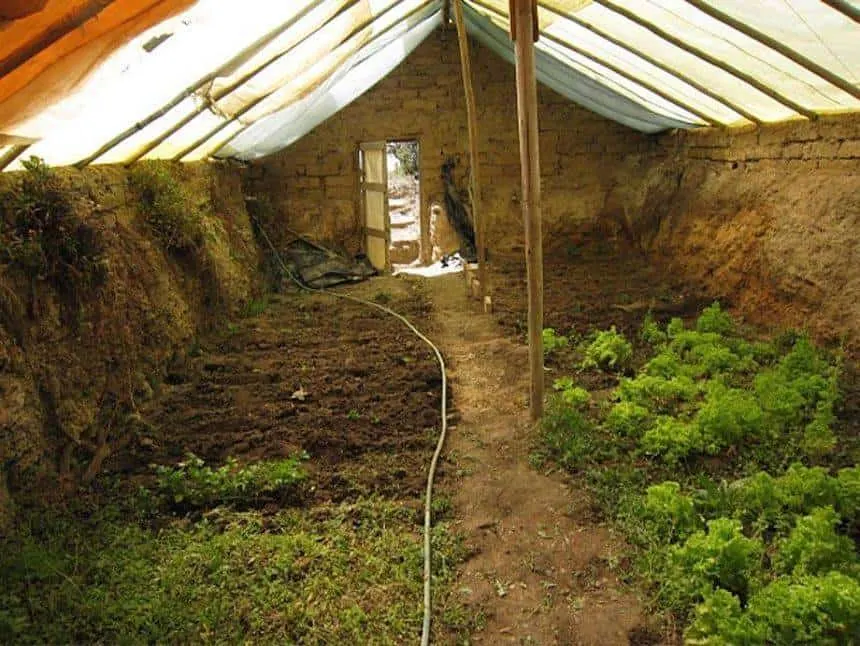
The next few DIY greenhouses on this list utilise clever design and ancient ideas to make structures that will keep plants warm all winter.
The walipini is basically a sunken, greenhouse-like structure, or earth-sheltered cold frame, that keeps plants warmer by borrowing heat from the ground.
The word ‘walipini’ means ‘place of warmth’ in the Aymara language of an indigenous Bolivian tribe. These structures were and are used in Bolivian communities. Now, these types of structures have been created all over the world.
Get the full tutorial at TreeHugger.com
Earth-Sheltered Greenhouse
Not only will using the earth provide warmth to a greenhouse, it can also be the best way to create a greenhouse on a sloping site. If you have a south-facing slope (in the northern hemisphere), this could be an ideal place to build an earth-sheltered or bermed earth greenhouse.
Get the full tutorial at MotherEarthNews.com
Earth Bag Walipini Greenhouse
This DIY plan shows how you can use earth-filled bags to line the underground section of your walipini style greenhouse. The earth bags store the sun’s heat during the day and release it later, evening out temperature fluctuations and increasing the length of the growing season.
Get the full tutorial at LowTechInstitute.org
Straw Bale Greenhouse
Earth is not the only thing that can be used to add thermal mass and provide extra insulation and warmth on the northern side of a greenhouse.
Straw bales can be used to form part of a greenhouse structure. These are warm, natural, easy to work with and relatively cheap, and so are an excellent choice for sustainable garden DIY builds.
Get the full tutorial at MotherEarthLiving.com
Cob & Straw Bale Greenhouse
Cob is another natural and sustainable, thermally efficient building material. It too can be used, sometimes in conjunction with straw bales, to support a plastic (or glass) roof on the northern side, while large areas allow the sun to shine in from the south.
Get the full tutorial at CycleFarm.net
Earthship Greenhouse
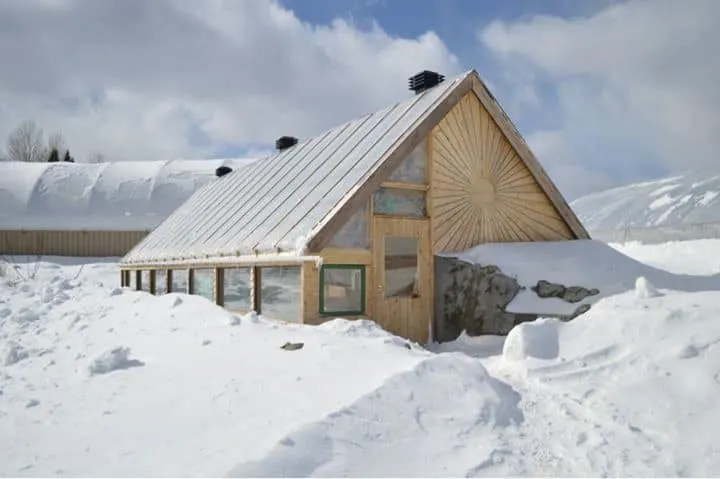
Not all DIY greenhouses need to be lightweight, temporary-feeling structures.
Like the earth-sheltered, straw bale and cob options described above, these next few ideas are all about a more permanent growing area that will form an integral part of a sustainable lifestyle.
In an Earthship, made using sustainable construction techniques, a greenhouse is built as an integral part of a home.
Trash and natural materials are used in the build, which can largely be undertaken by unskilled novices, and the garden greenhouse is not relegated to the end of the garden but is part of the home.
You will need to pay for this tutorial. Get the full tutorial which includes the film, ebook and plans at GreenhouseOfTheFuture.com
Recycled Glass-Window DIY Greenhouses
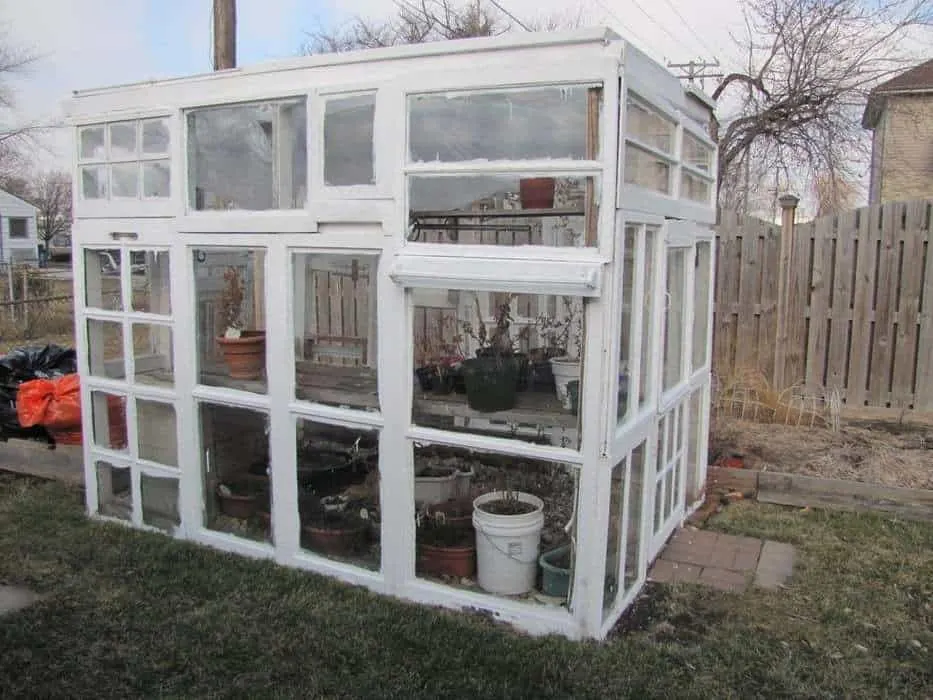
Purchasing new glass or new windows for a greenhouse is often very expensive when compared to the other ideas on this list. But recycled glass windows – from your home or from a local reclamation yard, can be a wonderful resource and can be used to create a range of different greenhouses. One example is found through the link below.
Get the full tutorial at Instructables.com
Glass Jar DIY Greenhouses
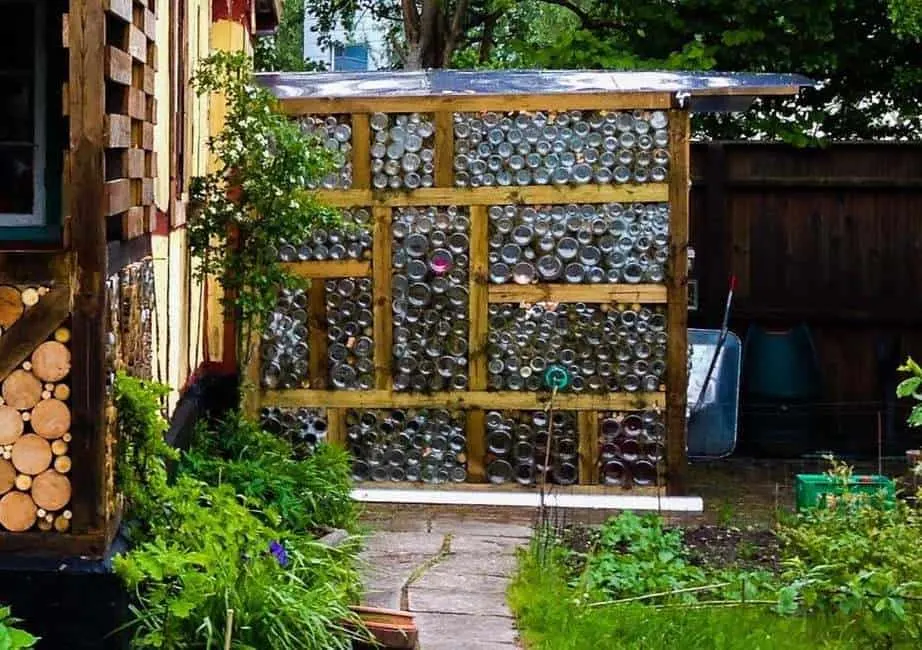
Just as above, we discussed how plastic bottles could be used in place of sheet plastic, so too glass jars or bottles could potentially be used in place of glass sheeting.
This could be another good way to recycle household waste in your garden. Check out this innovate idea below, which uses glass jars to allow light into a greenhouse structure.
Get the full tutorial at Instructables.com
There are, of course, many, many more amazing DIY greenhouses out there to choose from.
Whichever option you choose, the important thing is to choose an option that is suited to you and your particular location. To make sure your greenhouse is as green as possible, it is also a good idea to use natural materials available around you, or reclaimed items from your local environment.
The best DIY greenhouses are always those that have a minimal impact on our planet, while working effectively to help us grow our own food.
Pin This To Save For Later
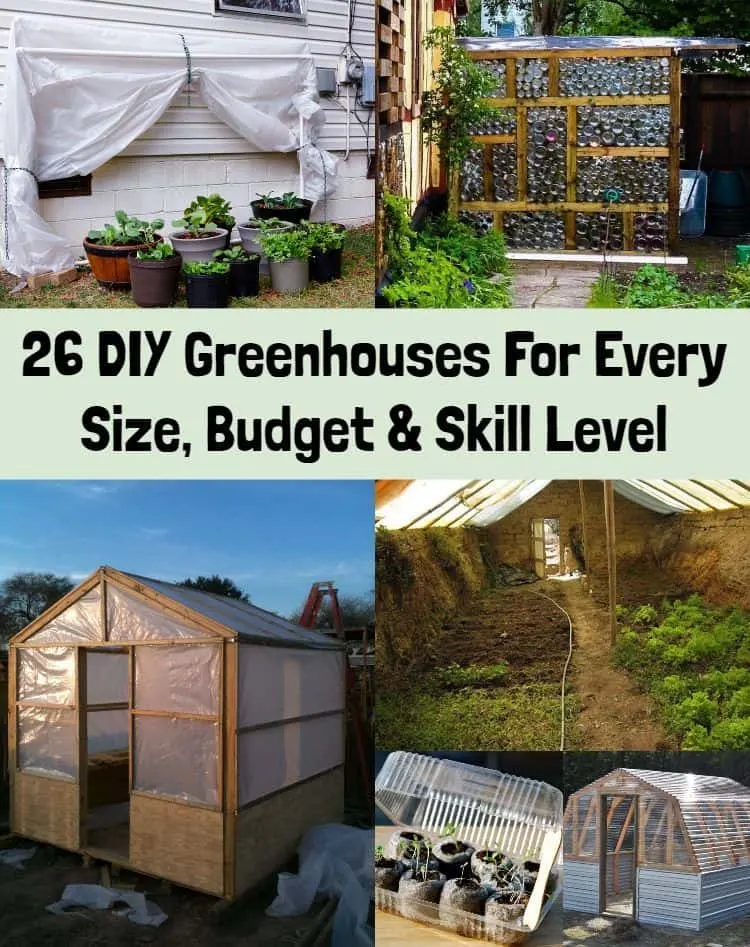

Get the famous Rural Sprout newsletter delivered to your inbox.
Including Sunday ramblings from our editor, Tracey, as well as “What’s Up Wednesday” our roundup of what’s in season and new article updates and alerts.


